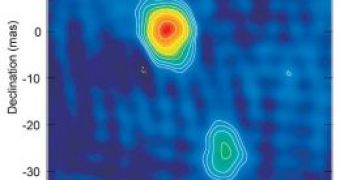Quasi stellar objects, or quasars, are the most powerful celestial bodies in the universe, capable of emitting enough energy to be observable across the whole visible universe. The European VLBI Network of radio telescopes has now discovered what appears to be the most distant quasar ever detected. Observations were carried out in the 1.6 GHz frequency with ten radio telescopes scattered across Europe, China and South Africa.
The featured image reveals the quasar dubbed J1427+3312, a double morphology between two components separated by approximately 480 light years, typical for young radio sources. The light we are currently receiving from this particular quasar was created when the universe was less than 10 percent of its current age, meaning it is the most distant quasar ever discovered. J1427+3312 is in fact relatively close to the inner edge of what is called the Epoch of Reionisation, or the Dark Ages of the universe, when ordinary matter started appearing only to create the first stars, then galaxies and finally the universe as we see it today.
"It is a powerful lighthouse that happens to be located at the place where we want to light up surroundings in search for something terribly important; one day, with new radio telescopes, we will 'use' this lighthouse as a handy tool in the search for EoR signatures", said Leonid Gurvits, Senior Astronomer at the Joint Institute for VLBI.
Zsolt Paragi, Senior Support Scientist at JIVE, believes that the fact that an image of the J1427+3312 quasar was obtained is testimony to the advancements made by radio astronomy technologies in the last couple of years.
"In this observation, owing to the extremely high data rate registered by all ten telescopes, we were able to achieve a sensitivity which was unthinkable just a few years ago. The combined data rate at the entry point of the EVN data processor at JIVE for this experiment was 10 Gigabit per second - an equivalent of about 1000 DVD movies played simultaneously", he said.
The discovery of a quasar so young in the early universe, says Gurvits, is to astronomers like finding one of the Seven Ancient Wonders, even though they are used to finding unusual objects across the visible universe.

 14 DAY TRIAL //
14 DAY TRIAL //